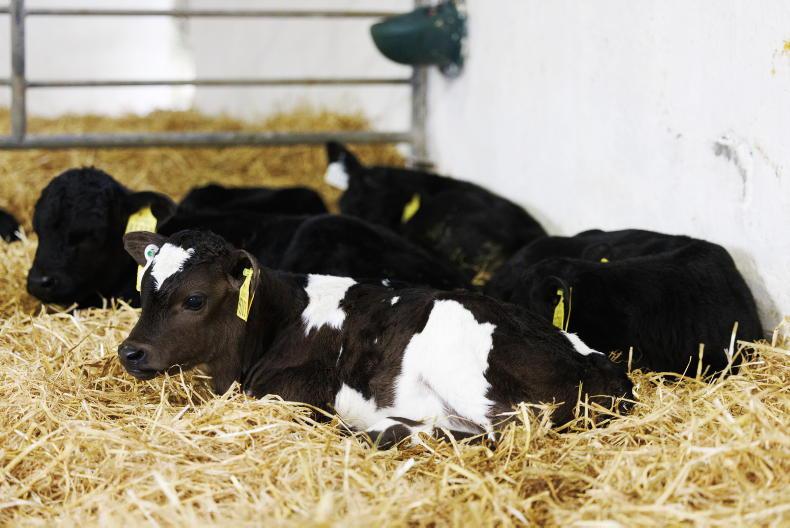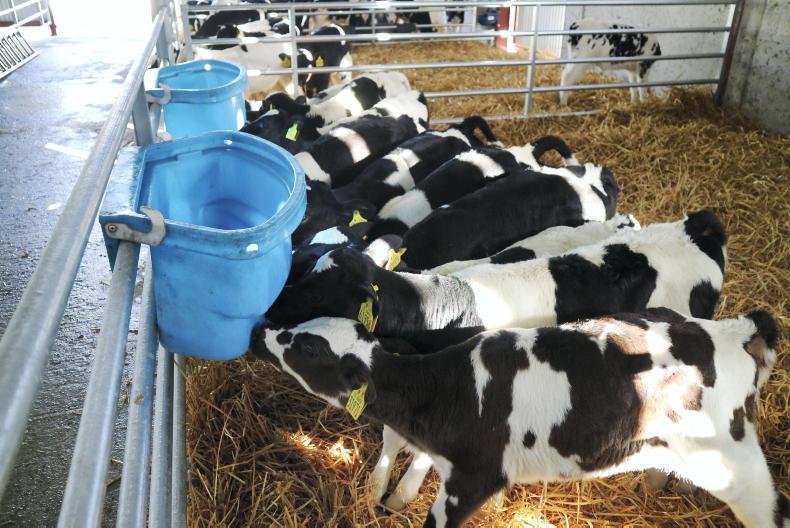The latest research on calf rearing has found that feeding higher rates of milk replacer leads to both short and long-term benefits, according to Dr Aaron Brown from Trouw Nutrition.
At a calf rearing event in Coleraine on Tuesday, Brown said the basis for new research has been to assess how a calf would behave in its natural environment.
A key theme has been to look at how much milk a calf would it consume if it was left on the cow, and studies have found this can be up to 12l of milk per day.
“They have the ability to consume a lot more milk than we think,” Brown said.
He cited studies which found that an increase in milk allowance leads to higher liveweight gains, better gut development and improved immune status, as well as an increase in fertility, longevity and lifetime milk yields.
The large volume of milk that a calf can potentially drink compares starkly to a recent farmer survey, which found over half of respondents were feeding 6l per day or less.
“Traditionally, calf rearing has been seen as a cost centre on many farms where the aim was to do it as cheaply as possible,” Brown said.
Rations
The Trouw representative maintained that offering higher rates of milk replacer will not reduce consumption of starter rations, as this is a common reason for restricting milk intakes on farms.
He described solid feed intake in the first three weeks, which tends to be around 50g per day, as “negligible”.
Brown detailed how gradually weaning calves off milk replacer over a three or four week period has the effect of allowing starter intakes to increase to typical levels of 2.5kg per day or more.
Fat and lactose
However, Brown said milk replacers with low levels of fat and a high lactose content are not suited for feeding higher rates. “Some milk replacers do not lend themselves to it,” he maintained.
Again, he compared it to natural cow’s milk which is high in fat and low in lactose, so it is energy dense.
Studies were cited which found that offering higher fat content milk replacer leads to better gut formation, reduced mortality rates, improved faecal scores and reduced health issues.
“Milk is more than just a collection of nutrients. It also imprints signals that have a permanent impact on heifer development,” Brown said.
Vaccines cover four main types of calf scour
Cryptosporidiosis accounts for 35% of calf scour samples submitted to the Agri Food and Biosciences Institute (AFBI), said Alise Callaghan from MSD Animal Health.
Speaking in Coleraine, Callaghan said the latest AFBI figures show 30% of calf scour cases submitted for analysis are rotavirus, 14% are coronavirus and 10% are E. coli.
The MSD vet presented figures which suggested every case of calf scour on an NI dairy farm typically costs at least £60.
The figure accounts for treatment costs and reduced growth rates, but it does not consider the extra labour and time associated with treating scour outbreaks.
Target
Callaghan said to hit a liveweight target of 420kg at 15 months for breeding, then 650kg at 24 months for calving, requires an average daily liveweight gain of 0.85kg.
“It is achievable, but it is still quite a significant weight gain, so there isn’t much room for checks in growth rates as any setback can be hard to recover from,” she said.
Nutrition, hygiene, colostrum management and vaccination were outlined as key factors in the calf rearing process which dictate if liveweight targets will be met.
Vaccine
With a vaccine for cryptosporidiosis launched last year, it means vaccines are now available which cover the four main causes of scour in calves.
Callaghan said Bovilis Cryptium, was “20 years in development” and it requires two shots in the first year, administered below the skin four to six weeks apart between 12 to three weeks before calving.
After that, there is a single shot annual booster, also given within the twelve-to-three-week pre calving window.
Callaghan said Bovilis Cryptium can be administered at the same time as Bovilis Rotavec Corona, which helps provides immunity for rotavirus, coronavirus and E. coli scour.
Vet consultant offers colostrum advice
Veterinary consultant Dr Ryan Davies offered colostrum management advice to farmers at Tuesday’s calf rearing event. He said calves should get a volume of colostrum within the first two hours which equates to 10% of their body weight, so usually around 4l.
He recommends a second feed within six to eight hours at around 5% of body weight, so half the volume of the first feed.
Davies said colostrum quality should be checked regularly with a refractometer, and it should have a brix score of at least 22%.
A score higher than that is better though, as studies have found colostrum with a brix score of 30% contains twice as many antibodies for immunity than 22% brix colostrum.
He recommends regularly blood testing calves to check antibodies levels, which can indicate whether they have received adequate amounts of good quality colostrum.
Davies said the “gold standard” test usually costs £12 per sample, but quicker and cheaper tests can be carried out by local vets. “It should not cost much at all,” he said.






 This is a subscriber-only article
This is a subscriber-only article











SHARING OPTIONS: